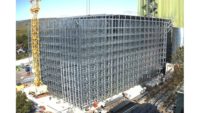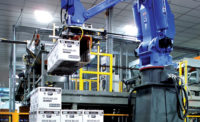Today’s food industry poses a considerable share of challenges, including rising prices, supply-chain complexities, and workforce recruitment and retention. In such a complex work environment, snack and bakery companies must analyze every aspect of their operation in order to discover opportunities to improve efficiency. In order to learn more about how to improve warehouse shipping and receiving operations, we reached out to Jim Gaskell, director of global automation and emerging technologies, Crown Equipment Corp., New Bremen, OH.
Douglas J. Peckenpaugh: What are the features of an efficient food industry warehouse environment today?

Jim Gaskell
One of the main ways warehouse managers can maintain or increase productivity and efficiency is to ensure they have the right mix of lift trucks for their operations and objectives. This is more than right-sizing. While ensuring their fleet is being utilized by the right operators, at the right times, in the right locations is important, it is equally important that they have the right trucks and technology to effectively and efficiently get products out the door.
For instance, if they need to go higher in the warehouse to increase storage density within existing space, then they need a forklift that can optimize warehouse slotting by placing heavier loads at higher heights with faster speeds while also maintaining safety standards with greater operator control and visibility.
This can also include having the right blend of manual and automated forklifts. Technology has advanced to the point that many of the challenges warehouse managers currently face can be solved—or significantly reduced—with today’s automated technology.
For instance, dual-mode technology that uses natural features navigation enables warehouses to take an incremental approach to deploying automated material handling solutions with minimal or no supporting systems or infrastructure. Operations that have not automated because they anticipate unavoidable process exceptions can leverage dual-mode vehicles to automate where it makes sense and retain manual operation to help address these exceptions.
Forklifts with dual-mode automation technology can switch between automated and manual operations to accommodate dynamic changes in the production plan. They feature an intuitive user interface that trained employees can efficiently operate. The forklifts integrate with the warehouse management system in automated mode to ensure a consistent workflow customized to fit the operation.
DJP: How does automated warehouse technology and equipment fit into today’s warehouses? What types of tasks can they accomplish, and what are their top features?
JG: It is important to understand that not all warehouse tasks are candidates for automation. It depends on the available technology, the amount of customization and complexity involved and how easy it is to incorporate new workflows and processes to integrate the automation.
Warehouse managers need to identify the tasks and equipment within their operations that are well suited for automation. Some of the warehouse tasks that have shown to be ideal candidates for automation include load transportation throughout the warehouse and full pallet put-away and retrieval.
It helps if they have a good understanding of how forklifts are being used and how and when pallets are moving in the facility. Where can warehouse employees be relieved of non-value tasks to focus on more strategic and value-adding tasks that enhance operational performance?
Telematics systems can play a vital role in implementing forklift automation by identifying potential use cases, informing the automation strategy, measuring performance, and helping ensure success. Depending on the system setup and the measurement metrics being used, warehouse managers can gather a wealth of data about their operations and how pallets move throughout the facility.
There is no plug-and-play approach to warehouse automation. Developing an effective automation strategy requires understanding the specific challenges a particular warehouse is facing and a thorough evaluation of the automation technologies available to address those challenges. But there are proven solutions available today as well as best practices for implementing and scaling these solutions.
DJP: How can automated warehouse equipment and human personnel work together for improved efficiency?
JG: Where introducing automation into the warehouse once required a high level of sensitivity to workers’ concerns regarding how the technology would affect their assignments and tasks, today’s workforce is more likely to embrace the positive outcomes of automation. Many companies find that workers appreciate the value of automation and expect a certain level of technology in their work environment. Effective use of technology has even become a tool in recruiting and retaining warehouse workers.
Nevertheless, introducing automation into the warehouse represents a change that directly affects workers, and change management strategies should be embedded into any implementation plan. Change management strategies can best be shaped by having at least one implementation team member that can view the plan, and the resulting changes to processes, through the lens of frontline workers. This helps ensure an understanding of how automation will affect workers and what employees will expect and experience during and after the implementation.
The goal of most automation deployments today is to better leverage the skills and expertise of the workforce by automating repetitive tasks and enabling workers to focus on high-value tasks. Complementary intelligent and semi-automated technologies can support this goal by allowing higher productivity for workers freed up by automation. Here are two automation technologies to consider:
- Operator-assisted picking: If operator productivity in picking applications is a key driver of automation, a semi-automated solution may be the most feasible and effective approach. This technology can yield productivity improvements of up to 25%.
- Auto positioning: For high-reach applications, locating and traveling to specific pallet positions can be time-consuming and drain productivity. Forklift auto positioning technology ensures reach trucks take the most effective route to a specified rack location, increasing operator productivity up to 25%.
For more warehouse operations insights, view recent Warehouse/Distribution content on SnackandBakery.com.







